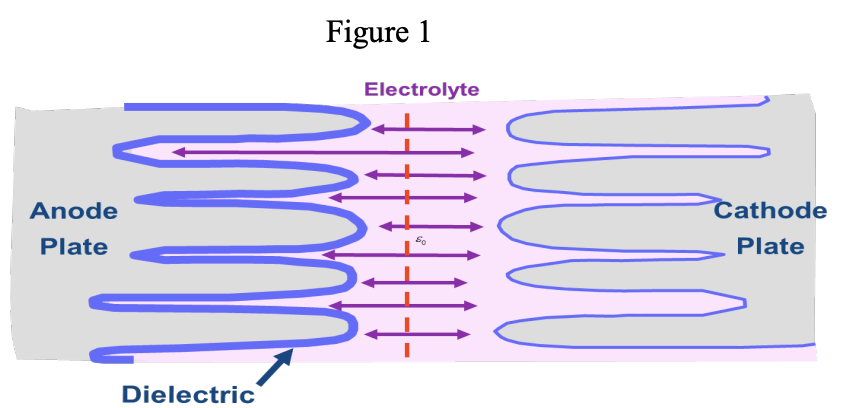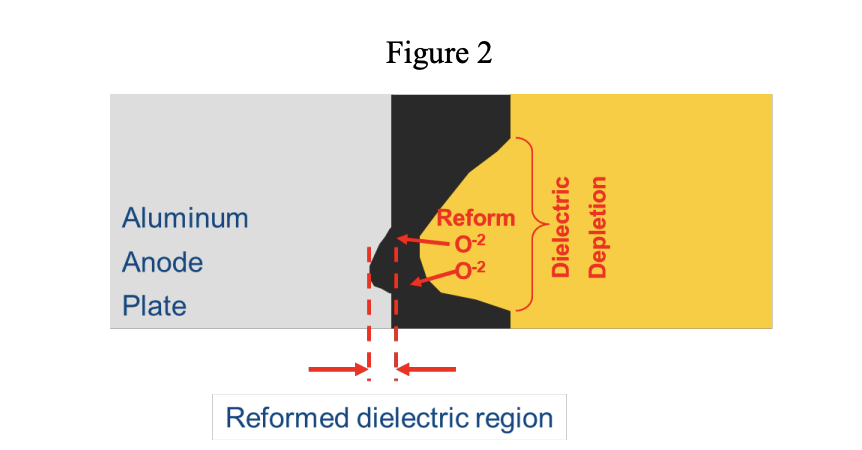Applied power plays a large role in the life of aluminum electrolytic capacitors. When no power is applied, the electrolyte attacks the aluminum oxide dielectric and lowers the voltage capability of the part. Once powered, the electrolyte is still reducing the dielectric, but the leakage current is working at the same time to reform the dielectric layer and bring the system to a steady state equilibrium. From this information, one would think that it might be better to leave the capacitor powered to preserve the life of the part. However, this is not the case. This paper will discuss what happens to aluminum electrolytics with and without power and what the best practices are to preserve the life of the part.
Aluminum electrolytic parts contain acid etched aluminum foils that serve as the anode and cathode. These foils are separated by an electrolyte material. Aluminum oxide serves as the dielectric, as seen in Figure 1 below.

The electrolyte attacks the aluminum oxide layer and reduces it back to aluminum. When powered, part of the initial leakage current will start reforming the dielectric. During reformation, the oxygen atom is split from the H2O in the electrolyte. This atom combines with the aluminum to create aluminum oxide. The leftover hydrogen gas is slowly released. Screw terminal parts have a vent specifically for the release of the gas, and in smaller parts, the gas is released through a gasket between the body and lid of the part. The process by which the dielectric is reformed is referred to as “self-healing.” Figure 2 below illustrates the process.

Leaving the capacitor unpowered for long amounts of time is not ideal because the self-healing process can only take place when power is applied to the part. If the capacitor has been left unpowered for too long and is then powered, the reforming process will occur much too rapidly. Large amounts of hydrogen gas will build up within the body of the part and cause the can to rupture.
To keep the part from rupturing, it is important to power the system periodically to allow the dielectric to reform. If your capacitor has been left unpowered for extended periods of time or has been in storage, a reforming procedure can be completed to ensure the part is not damaged. This reforming process usually involves applying rated voltage to the capacitor for a certain amount of time. KEMET’s datasheets provide information on the reformation process for each part series.
From this information, one might think that it is best to leave power on your aluminum electrolytic capacitors to keep the dielectric from depleting. However, dielectric depletion is a function of time as well as temperature. A powered capacitor is usually a warmer capacitor, and the electrolyte will reduce the dielectric at a faster rate at higher temperatures. Self-healing is occurring in this scenario; however, the process of self-healing depletes the electrolyte. Therefore, when left powered, aluminum electrolytic capacitors will age more rapidly.
So, we know we don’t want to leave our system continuously powered, but we also don’t want to leave it unpowered for too long. Where is the happy medium? Unfortunately, there is no one right answer to this question that would encompass all aluminum electrolytic. The type of electrolyte used in these devices varies by manufacturer and even by part series. Various electrolytes will attack the dielectric at different rates, causing some parts to require more time in a powered state than others. In general, the smaller radial and surface mount electrolytic use more aggressive electrolyte since they use higher gain foil. They will have a shorter life and require more dielectric reforming than corresponding much larger electrolytic with lower gain foil and less aggressive electrolyte.
LeAnna Weakley